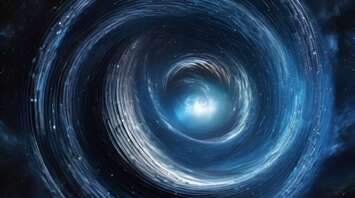Improved Study on Gravitational Waves from Failed Warp Drive

Physicists have long been fascinated by the theoretical concept of "warp drives," and a recent study in the "Open Journal of Astrophysics" has taken it a notch further by simulating gravitational waves generated if such a drive failed.
While warp drives could, in theory, allow travel faster than light, practical issues such as the need for exotic matter with negative energy make their construction implausible. Additionally, the warp drive metric is problematic; it can potentially violate causality and be difficult to control.
A collaboration of experts from Queen Mary University of London, University of Potsdam, MPI for Gravitational Physics in Potsdam, and Cardiff University examined what might happen during a warp drive "containment failure." Though they didn't solve the practical issues of building a warp drive, their simulations reveal fascinating theoretical consequences.
Dr. Katy Clough, lead author from Queen Mary University, noted, "Warp drives exist theoretically under Einstein’s General Relativity. Numerical simulations help us visualize their influence on spacetime through gravitational waves."
Dr. Sebastian Khan from Cardiff University added, "Miguel Alcubierre's creation of the first warp drive solution during his Ph.D. at Cardiff naturally inspires us to persist in exploring warp drive research within gravitational wave astronomy's scope."
Results confirm that a collapsing warp drive emits gravitational waves detectable by future high-frequency instruments that don't yet exist but could be built. These waves present a brief, high-frequency signal distinct from current ones captured from black hole or neutron star mergers, opening avenues for detecting warp drive technology, despite our inability to build it currently.
Dr. Khan remarked, "Though the signal is dependable in principle, given its speculative nature, it doesn't yet warrant development of new instruments solely for this purpose."
The study also focuses on the energy behavior of the collapsing drive, emitting waves of negative energy followed by alternating positive and negative waves. This dynamic interaction raises overall system energy, potentially another identifier if the waves meet normal matter.
"This groundbreaking work advances our understanding of negative energy spacetime dynamics and their broader implications in physics," commented Prof. Dietrich. "Such methods could unveil more about our universe's evolution or black hole singularity avoidance."
Dr. Clough added, "Theoretical explorations offer new discovery paths in the universe, warranting pursuit despite skeptical odds."
Future investigations by these researchers will assess signal variations across different warp drive models and study warp bubble collapses exceeding light speed. While warp speed remains futuristic, understanding the universe's complexities progresses, one simulated scenario at a time.
Earlier, SSP wrote about the ultra-rare discovery revealing black hole concealed at the core of the Milky Way.



















